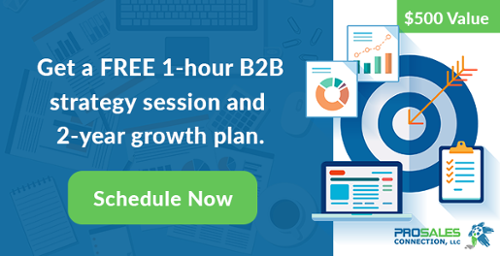Demand generation strategies are critical to getting your target customers exactly where you want them: aware of your brand and ready to buy from you.
Demand generation can be summarized as a host of techniques that you can use to create more interest in your products and services.
While every B2B company's marketing department or agency will likely run demand generation campaigns, they won't all look the same.
In previous articles, we reviewed key demand generation strategies that you can employ to cultivate interest and get more leads, but how do you know which will work for your business?
Here, we'll walk you through some research on how and why these demand generation strategies work and how to make them work for you.
Build Your Blog to Demonstrate Expertise
Don't underestimate the power of a blog. In 2019, 86% of all companies used blog content as part of their marketing strategy. The reason is simple: sharing helpful information will not only establish you as an expert in your industry, but you can also gain the trust of your target customers.
The biggest struggle most business leaders have when starting a blog is deciding what to write.
Before you delve into complex topics and opinion pieces, start by answering the basic questions your customers are asking. Be sure to cover a range of questions asked from the top of the funnel to the bottom of the sales funnel right before making a purchase.
Some topics to consider discussing are:
- The pricing of your products or services
- How much similar products or services costs across the industry
- Comparisons of different service providers or manufacturers
- Helpful tips that may typically require a paid consultation to obtain
- How-to guides on how to use a product or service
If you want to tap into new ideas to get ahead of your competition, talk to your sales team and find out what real customers are asking. Which questions do they most commonly hear? You can also visit forums and social media groups to find out which issues your target customers are actively trying to resolve.
Will blogging work for your business?
Blogging is a valuable tool, but ranking on Google and other search engines is extremely competitive. On average, it takes more than three months to rank on page one of Google if your blog is deemed relevant and helpful by the search engine.
The success of your blog can depend on multiple factors. Let's say you work in a very niche market, and there aren't an abundance of informational resources available to your target customers. In this case, you might be successful more quickly if you build a well-planned and executed blog.
If your industry is littered with thousands of websites offering the same information that you plan to write about, it can take more time to succeed with your organic blog strategy.
The best thing you can do is try to produce better content than your competitors. Answer more questions, include helpful images, graphics, videos, provide your own research, and bring something new to the table.
Take a position and have a perspective. You don’t have to be contrarian just for the sake of it, but an unpopular opinion can generate more interest than content that supports the mainstream accepted perspective.
Things like domain authority can also affect the success of your blog, but you can gradually increase your DA by creating high-quality, link-worthy content.
The bottom line: don't be afraid to give too much away for free. Demonstrating your knowledge will position you as a leader in your industry and cultivate trust in your brand over time.
Optimizing Your Blog
For any blogging strategy to work, you need to make sure your website is following all the best practices of SEO. That means paying attention to your page speed, using target keywords in headers, titles, meta descriptions, and URLs, adding plenty of internal links, and providing original, non-plagiarized content.
Read more about optimizing your web pages for search engines.
Share Your Expertise on Social Media
One surprising pattern that we've discovered is not all businesses have a strong presence on social media. However, we highly recommend that you share content on social media to connect and communicate with your target customers if you're not currently doing so.
You don't need to post on all platforms, but if you're new to social media and a B2B company, we recommend starting with Facebook and Linkedin and branching out from there.
What types of content can you share on social media?
You can use social media to share company announcements, blog posts, infographics, presentations, videos, promos, and thought-provoking questions. You can even share interesting articles released by other publications if they're relevant to your audience.
If you develop a sizable following, you can start doing regular live streams to answer questions in real-time.
The key is to continually provide relevant resources that will attract your target customers and help position you as an expert in your industry.
If you want to reach people outside your social media following, be sure to use hashtags and quickly jump on any trending topics that are relevant to your industry. Be careful not to “promote” as you contribute to the conversation. Just add your thoughts and perspective. If people engage with your comments, you can subtly take the conversation off-line to explore a business engagement.
How to Support Your Demand Generation Efforts with Social Media
Demand generation methods vary across social platforms. However, no matter which social platform you're using, make sure your profile, page, or bio is optimized. Be clear about what you offer, add a link to your website, and choose your copy and photos wisely.
Also, let followers know how they can get in touch with you, and check your DMs or listed email often.
Learn more about how to generate demand on LinkedIn, Facebook, Twitter, and YouTube.
Will social media work for your business?
Most consumers are accustomed to being able to find and communicate with companies on social media. While they may not always follow you, there's a tremendous opportunity to reach new people, raise brand awareness with social posts, and reach large audiences with advertising using low budgets.
While creating social content can be time-consuming, posting on social media is a free and easy way to get your brand exposure to your target customers.
Use PPC Display Advertising
Search ads are often more effective at generating leads than display ads. However, if your goal is to make your target customers aware of the problems that your products or services can solve, PPC display network advertising is one strategy that is worth trying.
Do display ads work?
When it comes to lead generation, you may be better off with traditional search campaigns. This is because they are delivered to those who are already actively seeking a solution to their problem. For demand generation campaigns, display ads can create more brand awareness and help you get in front of your ideal customers before they even realize they have a problem.
While creating your ads, remember to cover the pain points of your target customers and illustrate with words, graphics, and images how you can make their lives easier. Also, consider including free offers that can immediately provide a benefit to your audience.
Create High-Quality Free Resources AKA Lead Magnets
This is one thing that most businesses should be doing in some form to generate leads and support demand generation campaigns. Traditionally, companies may offer a free ebook or webinar in exchange for emails as a lead generation strategy. These are both very useful tools for collecting prospect information, but there are many other creative ideas that you can try, including:
- Courses
- Sessions or consultations
- Templates
- Checklists
- Free trial
- Ebooks and guidebooks
- Audits
Be sure to give your helpful resources compelling names. Make them irresistible to your target audience by avoiding generic titles and capturing their needs in your offer.
For example, we could write an ebook about B2B digital marketing and call it "The B2B Digital Marketing Guide for Business Owners." That doesn't sound bad, but it would get much more attention if we named our ebook "A B2B Business Owner's Guide to Ranking on Page One of Google and Making 50% More Sales in 6 Months". The second title is lengthy, but it's also more effective.
You work hard to create these resources, so take some time to think about what to name them. Consider polling a segment of your target audience, or send out a survey to your employees to help you choose a name for your free product.
Tip: try something simple like a checklist or template before diving into creating something bigger, like a video course or ebook. Despite being free, it can be a big ask for people who don't know your brand to read an entire ebook or sign up for a course.
You can use more than one lead magnet for your demand generation strategy. Just be sure to focus on quality over quantity.
Use Influencer Marketing to Expand Your Reach
Influencer marketing is a tactic most often used in B2C campaigns, but it can also be effective in B2B marketing.
In one 2020 survey, 74% of marketers agreed that B2B influencer marketing improves customer and prospect experience with the brand. Promoting your products or services through influencers gives you a unique opportunity to start a conversation about your brand and how it can help individuals or businesses solve their problems.
Here's one example of an influencer post for Amex Membership (aimed at other business owners) on Instagram.
Traditionally, influencers make their relationship with your brand personal in a sponsored post. These personal touches can forge a stronger sense of trust and connection between you and the influencer's followers.
Will B2B influencer marketing work for your business?
Finding quality B2B influencers is not always easy. It takes more than just a glamorous post to motivate key decision-makers to care about your brand.
For a B2B influencer post to be effective, they should have in-depth knowledge of your industry and be able to demonstrate that expertise in the sponsored content. Because not everyone with this knowledge has a big following (or the right kind of following), finding influencers to sponsor can also be tricky.
However, if you find the right people to work with who have followers who can benefit from your products or services, influencer marketing can be a valuable B2B demand generation tactic.
Create Buyer Personas
The practice of creating buyer personas, semi-fictional representatives of your target buyers, is standard in most marketing strategies. Buyer personas usually resemble personal profiles complete with a name, photo, and demographic information. Personas should be very specific and include as many details as possible about your ideal customers' interests and personal characteristics.
What's the point of making a buyer persona?
The general idea is to use personas as tools when making ads and other materials to target your desired audience. You can tailor your ads and organic content to line up with the age groups of your buyer personas, where they spend time, and their interests.
Make sure your personas include the challenges your target customers face and the problems they can solve by using your product.
Will using buyer personas work for your business?
It depends. Are your personas reflecting your real customers? Do they mirror your customer demographics and interests, or are they just made up of best guesses?
It's possible that your customers aren't who you initially thought they would be. You may even find that you've been targeting the wrong audience from the start.
When making buyer personas, be sure to use data from your real customers as a foundation. You may even use a customer's name and data in lieu of a fictitious persona when developing your content and marketing strategy.
Don't have any customers yet? If your business is new and you have not yet acquired sales, you can build personas using research on competitors and their customer base and update your personas with your customer data later on.
There is plenty of evidence that suggests the effectiveness of using buyer personas. Hubspot reported that using personas made websites up to five times easier to navigate by targeted users. Marketing Insider Group also found that 24% of companies generated more leads by using buyer personas.
Get Testimonials and Reviews
Does your website feature testimonials? If not, you might want to contact your happy clients and ask them to provide a testimonial or review.
Typically, testimonials are featured on the homepage of a website to help assure the legitimacy of the business to prospective customers. Testimonials can also be used on portfolio pages, case studies, landing pages, and in social media content.
If you want to increase your number of reviews and testimonials, you can ask your customers or clients to leave reviews on LinkedIn or Google as well as websites like Trustpilot and G2. These reviews are not controlled by the company and can encourage prospective customers to choose your business over your competition.
Have you checked your BBB reviews lately? If you're not registered on the Better Business Bureau's website, you can submit a request to get accredited. Accreditation from the BBB provides another source for online reviews and can significantly boost trust in your brand.
Will testimonials work for your business?
We don't have to ask whether this will work for your business because it will! Every business can benefit from positive customer reviews and testimonials on its website.
A good testimonial won't make a prospect outright buy your product, but it can strongly influence their decision-making process. Conversely, bad reviews can also be detrimental to your business. If you have many bad reviews on Google, Trustpilot, the BBB, or elsewhere, you'll want to address them quickly and make amends.
One thing to note is there's no simple way to delete a bad review from Google and other review platforms, as long as it came from a legitimate customer. You can flag inappropriate reviews, fake reviews, and spam, but it's against Google's policy to delete honest negative reviews.
Get Published
Get your brand name in front of your target audience by writing guest posts for popular websites, journals, and magazines in your field. Share these articles on your social media feeds to demonstrate your expertise and knowledge.
A few top publications that regularly accept guest writers include:
- Forbes
- Entrepreneur
- Fast Company
- Harvard Business Review
- MarketingProfs
- Business Insider
- The Financial Times
Do you have a really good idea or interesting opinion on a popular topic? You can pitch your article concept to a print or online magazine to further boost your social proof.
Will getting published work for your business?
Like getting reviews, publishing an article might not make people run out and request a quote for your product or service, but it will improve your reputation and help to establish you as an expert in your industry. Make sure to do plenty of research for your article and offer as many helpful points as possible to increase its shareability.
In addition to helping you raise brand awareness and positioning your name as an authority in your niche, getting published can drive traffic to your website and boost your sales.
If you want to learn more about B2B demand generation strategies, read about our ACTIVE DEMAND GENERATION METHODOLOGY next.
Are you ready to grow your business? Book a free 1-hour strategy session with us today and get a high-level overview of your goals and an updated 2-year growth plan.








